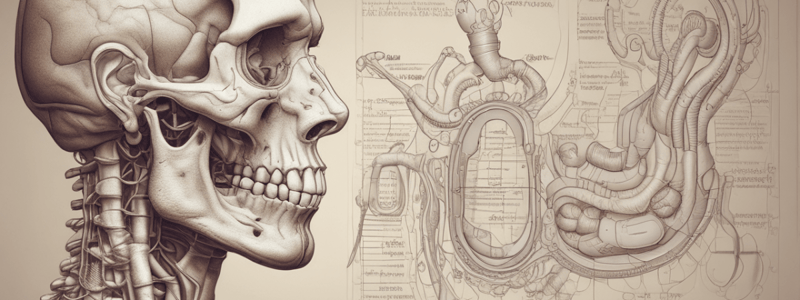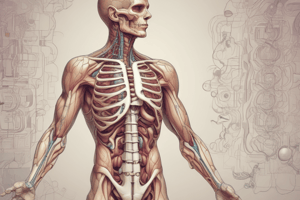Podcast
Questions and Answers
What is the primary function of the hepatic lobules in the liver?
What is the primary function of the hepatic lobules in the liver?
- Performing protein synthesis, bile production, and detoxification (correct)
- Connecting to the cystic duct
- Regenerating the liver itself
- Storing and releasing bile into the small intestine
What is the purpose of the cystic duct in the gallbladder anatomy?
What is the purpose of the cystic duct in the gallbladder anatomy?
- To connect the liver to the gallbladder (correct)
- To produce bile
- To release bile into the small intestine during digestion
- To merge with the common bile duct
What is a common consequence of hepatobiliary diseases, such as gallstones?
What is a common consequence of hepatobiliary diseases, such as gallstones?
- Increased bile production
- Pain, inflammation, and infection (correct)
- Improved digestion and nutrient absorption
- Enhanced liver regeneration
What is the name of the surgical procedure that removes the gallbladder?
What is the name of the surgical procedure that removes the gallbladder?
What is a unique characteristic of the liver?
What is a unique characteristic of the liver?
What is the primary function of the liver in the digestive process?
What is the primary function of the liver in the digestive process?
What is the purpose of the gallbladder in the digestion of food?
What is the purpose of the gallbladder in the digestion of food?
Which blood vessel is responsible for delivering blood to the liver?
Which blood vessel is responsible for delivering blood to the liver?
What is the main function of the sinusoids in the liver?
What is the main function of the sinusoids in the liver?
What is the primary function of the gallbladder in the digestive process?
What is the primary function of the gallbladder in the digestive process?
What is the role of the hepatic artery in the liver?
What is the role of the hepatic artery in the liver?
What is the function of the portal system in the liver?
What is the function of the portal system in the liver?
Flashcards are hidden until you start studying
Study Notes
Liver and Gallbladder: Functions, Anatomy, and Cell Biology
The liver and gallbladder are two vital organs in the human body that work together to aid in the digestion of food. The liver, a large organ located in the upper right quadrant of the abdomen, is responsible for producing bile, which is stored in the gallbladder. Bile is released into the small intestine through a series of ducts that connect the liver, gallbladder, and pancreas.
Liver Functions
The liver is the largest internal organ in the human body and plays a central role in the body's metabolic processes. It is responsible for:
- Detoxifying the blood and removing waste products
- Converting carbohydrates into glucose for energy
- Producing bile, which is stored in the gallbladder and aids in fat digestion
- Producing clotting factors, which help in blood coagulation
- Storing and regulating the levels of various vitamins, including A, D, E, and K
Hepatic Blood Flow and Portal System
Blood flow to the liver is regulated by the portal system, a network of blood vessels that carries blood from the gastrointestinal tract, spleen, and pancreas. The portal vein, the main vessel in the portal system, branches into the hepatic artery and the hepatic portal vein. The hepatic portal vein delivers blood to the liver, while the hepatic artery provides additional blood flow. Within the liver, the blood splits into smaller vessels called sinusoids, which eventually empty into the hepatic vein.
Liver Cell Biology
The liver is composed of functional units called hepatic lobules, which are made up of hepatocytes, or liver cells. These cells perform various functions, including protein synthesis, bile production, and detoxification. The liver is also capable of regenerating itself, making it a highly resilient organ.
Gallbladder Anatomy
The gallbladder is a small, pear-shaped organ located under the liver and is responsible for storing and releasing bile into the small intestine. It is connected to the liver via the cystic duct, which eventually merges with the common bile duct. When the gallbladder contracts during digestion, bile is released into the common bile duct and into the small intestine.
Hepatobiliary Diseases
Diseases of the liver and biliary system, such as gallstones, can block the flow of bile and cause pain, inflammation, and infection. These conditions often require surgical intervention, such as cholecystectomy, the removal of the gallbladder.
In conclusion, the liver and gallbladder play essential roles in the digestion of food and maintaining overall health. Understanding their functions, cell biology, and anatomy can help in the prevention and treatment of hepatobiliary diseases.
Studying That Suits You
Use AI to generate personalized quizzes and flashcards to suit your learning preferences.




